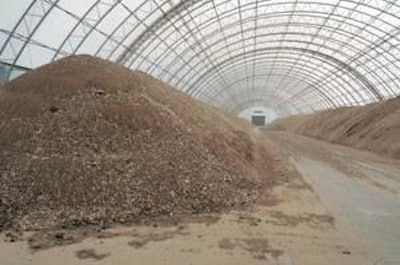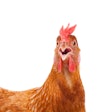
Controlling flies on egg farms has always been important because flies can serve as disease vectors and can be a nuisance to employees and neighbors. With the heightened emphasis on Salmonella control on egg farms and the role flies can play in moving Salmonella within and between layer houses, effective fly control programs are a must for all egg farms.
Pest control experts agree that modern layer houses with manure belts and properly engineered ventilation systems that dry the manure on the belt can provide a virtually fly-free environment in the layer house rather easily. Deep-pit or high-rise houses present a real fly control challenge on egg farms, but with a commitment of personnel and resources, even deep-pit houses can be kept virtually fly-free.
Tackling the challenge
Employees and management on many egg farms have tolerated a certain number of flies on their premises as being normal, and keeping fly numbers at or below these levels has been considered acceptable. The first step to eliminating flies is to adopt the mind-set that the virtual elimination of flies is an attainable goal and that the entire organization will work towards achieving this objective.
Robert Rowland, technical service entomologist, IVESCO LLC, said that really controlling pests means that each farm needs to have dedicated employees who are trained in pest control. “You need a lead person for whom rodent and fly control is their job, and they need a small crew of people who help with the treatments. This requires a commitment of manpower, but because of the savings on control chemicals, it winds up being about a wash in total cost. Because, if your fly and rodent numbers never get high, then you don’t use as many chemicals,” Rowland said.
Keeping manure dry
Controlling flies starts with drying the manure and keeping it dry. “In a pit house, it is imperative that we get the manure dry to discourage fly breeding; below 40 percent moisture or even lower if possible,” said Dr. James Arends, entomologist and president of JABB of the Carolinas. “At those moisture levels, no fly breeding is possible.”
Arends said that fly controls can be categorized as cultural, biological or chemical. Cultural controls are things like proper ventilation, stirring fans, drinker management for the birds and proper management of the outside of the facility to keep out rainwater. Chemical controls include all of the chemical insecticides. Arends said that some insecticides have resistance issues, and they must be used in specific places in the house to avoid killing beneficial insects. Biological controls consist of all the beneficial insects that live in the manure, and beneficial insects we can add, like parasitic wasps, and bio-insecticides like beauveria. Beauveria bassiana is a fungus that grows naturally in soils throughout the world and acts as a parasite on some arthropod species, like flies.
Ventilating the house to dry the litter relies on the humidity level of the air being drawn into the house being low enough that there is still some moisture carrying capacity left in it after it has removed respiratory moisture from the hens. Arends said, “During the summer, which is prime fly breeding season, we always get into periods of time where the outside air is very humid and has no carrying capacity left when it enters the poultry house; therefore, manure gets zero drying no matter how much air we run over it. In a pit house, if we have gotten the manure base into a dry condition, it can act as a sponge in times like this even though we lose structure to the manure pile (the pile flattens and changes color).”
Many deep-pit houses use stirring fans in addition to normal ventilation fans. The stir fans chase the air in the pit allowing it to pick up a full load of water prior to being pushed out of the building in the normal ventilation process. Arends said, “Spring and summer are the hardest times to dry manure, or any time we get a lot of cloudy weather. I tell people you cannot dry manure if the weather is not good enough to dry hay.”
The cleanout conundrum
Historically, many egg producers have cleaned the manure out of deep-pit houses annually in the spring or fall around the time fields are planted. This strategy minimizes the handling and storage of the manure after removal from the layer house and separates the removal of manure from the removal of birds from the house.
Having dry piles of manure in the pit when a new flock is brought into production makes fly control somewhat easier, according to Rowland. “When birds are in peak egg production, which happens shortly after they are placed in the house, their manure is runnier,” he said. If a base of dry litter is in place, it will absorb some of the moisture from these loose droppings and inhibit the development of fly larvae.
“Your fly problem is always the worst the first eight to 10 weeks after you remove the manure from the house,” Rowland said. The flies are a problem for the first eight to 10 weeks after manure clean-out because you have removed the beneficial insects that prey on the flies in various stages of their life cycle, and you don’t have the dry litter pile to absorb moisture out of the fresh droppings. To combat this, some egg producers have developed a protocol where they bring some old manure back into the barn after cleaning out. The old manure helps absorb moisture from the fresh droppings and also serves to reintroduce beneficial insects into the pit.
“The FDA wants you to do a total house cleanout and disinfection when a flock leaves the house,” Rowland said. This allows for the new flock to be brought into a clean house, which reduces the risk of Salmonella contamination carrying over from the previous flock, but it presents a challenge for fly control. You have a house with a reduced number of beneficial insects and no dry manure pile to absorb moisture from the young hens first coming into egg production.
Egg producers who have a cleaned-out house and hens entering lay with relatively loose droppings will need to be particularly vigilant with the use of fly control chemicals and beneficial insects to keep flies in check for the first eight to 10 weeks that the new flock is in the house, according to Rowland. “The monitoring of the pits is critical, and you have to do it,” Rowland said. “The most successful farms are checking the pits everyday. They have one person who is trained and knows exactly what to look for and what they are supposed to do when they find something.” They are monitoring for indications of flies, wet spots on the manure piles or maggots, before they become a problem.
Control strategy
Rowland said, “The secret in good fly control is you cannot just try and control one of the life stages of the fly; you have to do a very good job controlling at least two. Normally we try to control the adult, with insecticide, and the maggots [larvae], with IGRs [insect growth regulator].”
Rowland suggests spraying an insect growth regulator on wet spots on the accumulating manure pile to keep the maggots from developing, and spraying insecticide on the walls and posts in the pit area to kill adult flies. Spraying the walls with insecticide works because when the flies emerge from the pupal case they have to crawl out of the pit before they can fly. Spraying the walls of the pit with insecticide also keeps the darkling beetles in the pit. The best residual insecticides are encapsulated and can kill adult flies for one to two months.
Rowland also recommends the introduction of parasitic wasps into the pit area of a recently cleaned-out house to attack the flies when they are in the pupal stage. Using the combination of insecticide, insect growth regulators, and parasitic wasps gives an egg producer a control measure on three stages of the life cycle of the fly.
“The most important aspect of fly control is timing,” Rowland said. “You have to do what you have to do at just the right time. If the timing is absolutely correct, you will not see any flies.”
Because of the loose droppings and lack of dry manure piles in the pit area, fly control measures taken in the first eight to 10 weeks a flock is placed in a cleaned-out house can seem expensive. But Rowland said that costs for control measures should drop significantly for the rest of the life of the flock if you make it through the first couple of months fly-free. “During the first eight to 10 weeks, you may feel like you can’t afford to do this program, but when you annualize the cost, you can afford to do this,” he said.
Belt houses
Arends and Rowland agreed that a belt house, with a properly designed ventilation system for drying the manure on the belt, shouldn’t have fly problems. Arends said, “The problems I see are in belt houses that do not have the drying system in place, and when we get into humid weather, the manager must run the belts daily or every two or three days to stop fly breeding from taking place on the belts inside the building.”
When the manure is not dried on the belts then it can create a fly problem in the manure storage building. Composting manure in the storage building will help control flies, but if the wet manure is not composted, the storage building will have to be treated to control flies. Rowland recommends treatment of wet spots in the manure piles in the storage building with an insect growth regulator and spraying a good residual insecticide on the walls of the building.















